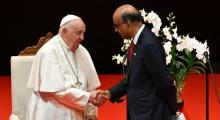Issued by the Catholic Center for Studies and Media - Jordan. Editor-in-chief Fr. Rif'at Bader - موقع أبونا abouna.org

Data revealed by the new Pew report names Christians as the largest religious group on the move, roughly 47 percent, significantly influencing religious demographics in both origin and destination countries.
Migration from Christian-majority regions like Latin America, Europe, and Sub-Saharan Africa has contributed to this trend.
Economic factors, political instability, and conflict have driven millions of Christians to seek new opportunities and safety abroad.
“People move internationally for many reasons, such as to find jobs, get an education, or join family members. But religion and migration are often closely connected,” the study said.
Muslims are the second-largest religious group among global migrants, accounting for 29 percent of the total.
The migration of Muslims, especially from conflict-ridden regions such as the Middle East, is largely driven by the search for stability and better economic prospects.
Jews, although a smaller group in absolute numbers, have the highest likelihood of migrating, with around 20 per cent of the global Jewish population living outside their country of birth.
“Many migrants have moved to escape religious persecution or to live among people who hold similar religious beliefs. Often people move and take their religion with them, contributing to gradual changes in their new country’s religious makeup,” the study said.
Sometimes, though, migrants shed the religion they grew up with and adopt their new host country’s majority religion, some other religion, or no religion,” it added.
This migration is influenced by both historical factors and contemporary challenges faced by Jewish communities in certain regions.
The study also indicates that migration has led to religious diversification in many destination countries, often introducing new religious communities into areas that previously had limited religious diversity.







